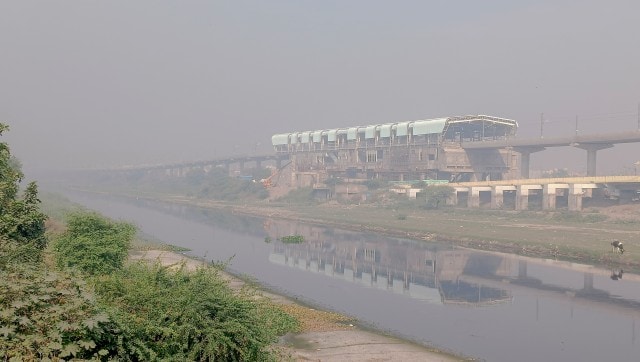Delhi has been covered in a heavy layer of haze over the past few days.
Its air quality has fallen into the ‘poor’ or ‘very poor’ level due to stubble burning and temperature drops.
The 11-point action plan outlined in Stage II of the
Graded Response Action Plan (GRAP) has been implemented to help address the deteriorating air quality.
The Delhi High Court also reaffirmed the ban on the sale of firecrackers on Monday due to the city’s alarming pollution levels.
Worst polluted city in India
Delhi recorded the worst 24-hour average air quality index (AQI) in the country on Monday (October 21) with an AQI of 310, according to data from the Central Pollution Control Board (CPCB).
An AQI between 0 and 50 is considered ‘good’, 51 and 100 ‘satisfactory’, 101 and 200 ‘moderate’, 201 and 300 ‘poor’, 301 and 400 ‘very poor’, 401 and 450 ‘severe’ and above 450 ‘severe plus’.
According to the CPCB, an air quality index (AQI) classified as “very poor” (red) can lead to respiratory illnesses in all people upon extended exposure.
Delhi’s AQI is predicted by IMD to remain in the “very poor” category during the next few days because of adverse climatic and meteorological conditions, as well as calm winds.
The National Capital’s air quality was 218 in 2023, 312 in 2022, 382 in 2021, 414 in 2020, 337 in 2019, 281 in 2018, 319 in 2017, and 431 in 2016, according to data from the Central Pollution Control Board (CPCB) on Diwali days.
Driving forces
Delhi’s
air pollution reaches extreme levels each winter due to a combination of low wind speeds, decreasing temperatures, high moisture content, and particulates that serve as surfaces for condensation.
Dr R Subramanian, Sector Head of Air Quality at the Centre for Study of Science, Technology, and Policy (CSTEP), said stubble burning in Punjab and Haryana emits a lot of particulate and gaseous pollutants, leading to pollution in Delhi.
“When the meteorology favours winds blowing from Punjab/Haryana towards Delhi, these stubble burning emissions are transported towards and pass over Delhi, contributing to increased pollution in the capital city,” he told News18.
Between September 15 and October 19, 3,376 fire and stubble burning incidents were reported in Punjab, Haryana, Uttar Pradesh, Delhi, Rajasthan, and Madhya Pradesh.
Gufran Beig, founder of SAFAR (System of Air Quality and Weather Forecasting And Research), told News18, “From now onwards, it is going to get worse. Peak (of stubble burning) is likely to be in the first week of November. It will depend on whether the peak will be reduced or not.”
He clarified that PM 2.5, the primary pollutant originating from vehicles, is not the main target of anti-pollution measures, rather PM 10, which primarily comes from dust and construction sites.
According to Sunil Dahiya, Founder and Lead Analyst, Envirocatalysts, the pollution in Delhi-NCR is still being caused by power plants, vehicle emissions, industry in Ghaziabad, Sonepat, and other cities, brick kilns, burning biomass in rural areas, and construction sites.
He told News18 that about 20 and 30 per cent of the pollution in the city is caused by vehicle emissions.
Additionally, a meteorologist has ruled out the chance of rain in the city, which could lower pollution levels.
Mahesh Palawat, Vice President Meteorology and Climate Change, at Skymet Weather, told the channel, “There is no possibility of a western disturbance in the coming days. The temperature is not dropping. If it does not drop further, air quality will not change much. Pollution during Diwali will also depend on wind speed.”
Firecracker ban
On Monday, the Delhi High Court upheld the ban on selling firecrackers, pointing to the concerning pollution levels in the National Capital.
Justice Sanjeev Narula stated in an oral observation that the court cannot allow the selling of firecrackers when the Capital’s air quality is still declining.
The remarks were made at a hearing on a petition submitted by the Delhi Fireworks Shopkeepers Association, which represents vendors who hold long-term permits to sell and store firecrackers.
The Delhi government announced its ban on firecrackers on September 9, effective until January 1. Environment Minister Gopal Rai said that all types of firecrackers, including green crackers, cannot be sold, purchased, stocked or manufactured in the Capital. The formal notification of the ban was eventually released on October 14.
Notably, a recent study by Delhi Technological University (DTU) researchers published in the journal Air Quality, Atmosphere & Health found that banning firecrackers can cut specific nanoparticle emissions by as much as 20–22 per cent.
Stage II GRAP
GRAP is an emergency air pollution control initiative.
It is invoked stage-wise by the Commission for Air Quality Management in NCR and adjoining areas.
In response to the poor air quality in the Delhi-NCR area, the CAQM formed a subcommittee to carry out all of the steps specified in Stage II of GRAP.
With effect from October 22, these measures are being implemented in addition to the Stage I measures that are currently in place.
According to Indian Express, the 11-point action plan in the Stage II category includes:
With inputs from agencies
Link to article –
Why is the Delhi air quality so poor despite firecracker ban?
